HA2032 Corporate & Financial Accounting Final Assessment T2 2021
VerifiedAdded on 2023/06/18
|10
|1980
|163
Homework Assignment
AI Summary
This document presents a solved final assessment for the HA2032 Corporate and Financial Accounting course. It includes detailed answers to six questions covering topics such as disclosing entities, capital reduction vs. share buybacks, acquisition journal entries, consolidated retained profits, consolidation data adjustments, and indirect ownership interests. The solutions provide calculations, journal entries, and explanations, referencing relevant academic sources. This resource is intended to aid students in understanding key concepts and improving their performance in the course. Desklib offers a wide array of study tools and resources for students.
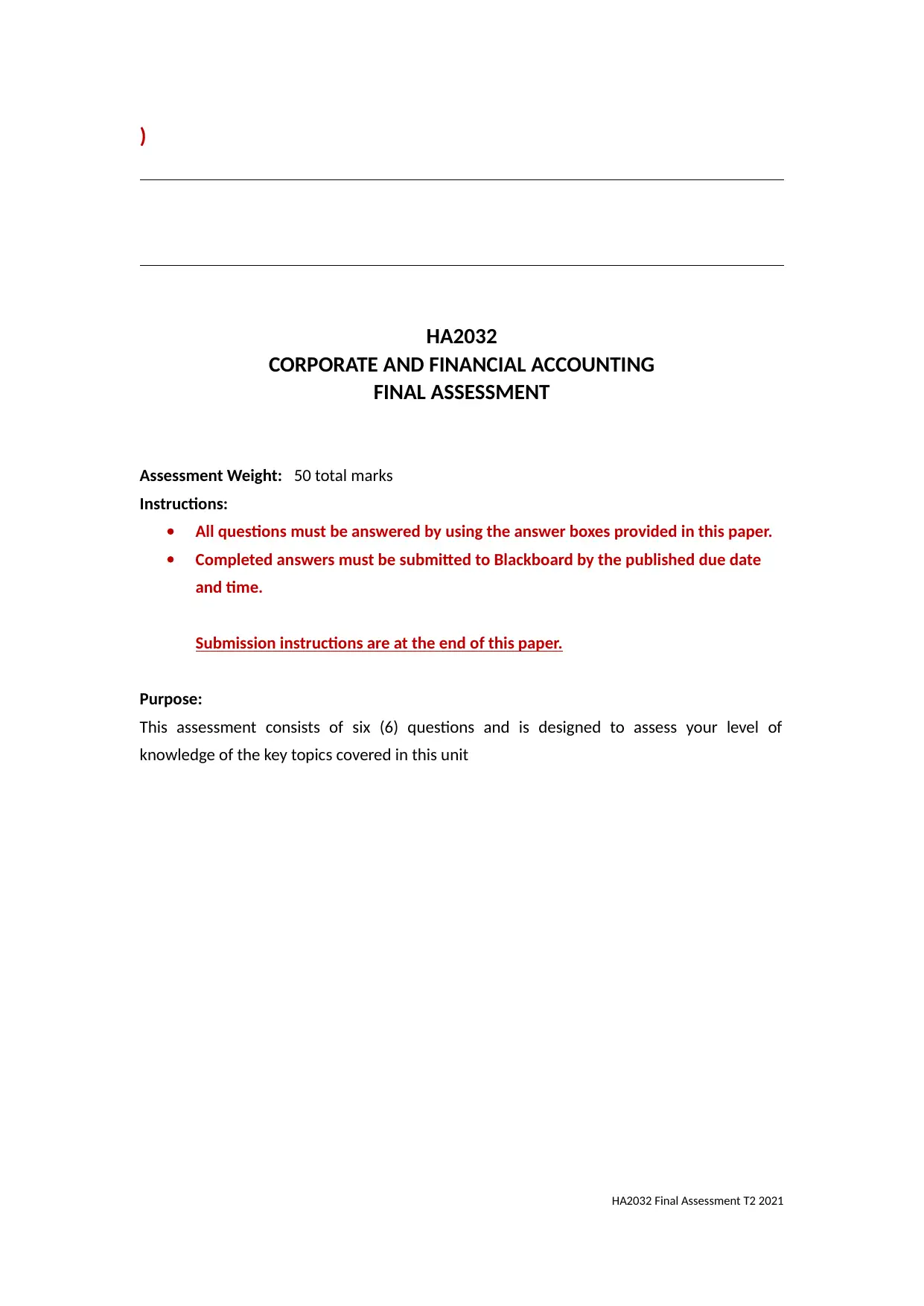
)
HA2032
CORPORATE AND FINANCIAL ACCOUNTING
FINAL ASSESSMENT
Assessment Weight: 50 total marks
Instructions:
All questions must be answered by using the answer boxes provided in this paper.
Completed answers must be submitted to Blackboard by the published due date
and time.
Submission instructions are at the end of this paper.
Purpose:
This assessment consists of six (6) questions and is designed to assess your level of
knowledge of the key topics covered in this unit
HA2032 Final Assessment T2 2021
HA2032
CORPORATE AND FINANCIAL ACCOUNTING
FINAL ASSESSMENT
Assessment Weight: 50 total marks
Instructions:
All questions must be answered by using the answer boxes provided in this paper.
Completed answers must be submitted to Blackboard by the published due date
and time.
Submission instructions are at the end of this paper.
Purpose:
This assessment consists of six (6) questions and is designed to assess your level of
knowledge of the key topics covered in this unit
HA2032 Final Assessment T2 2021
Paraphrase This Document
Need a fresh take? Get an instant paraphrase of this document with our AI Paraphraser
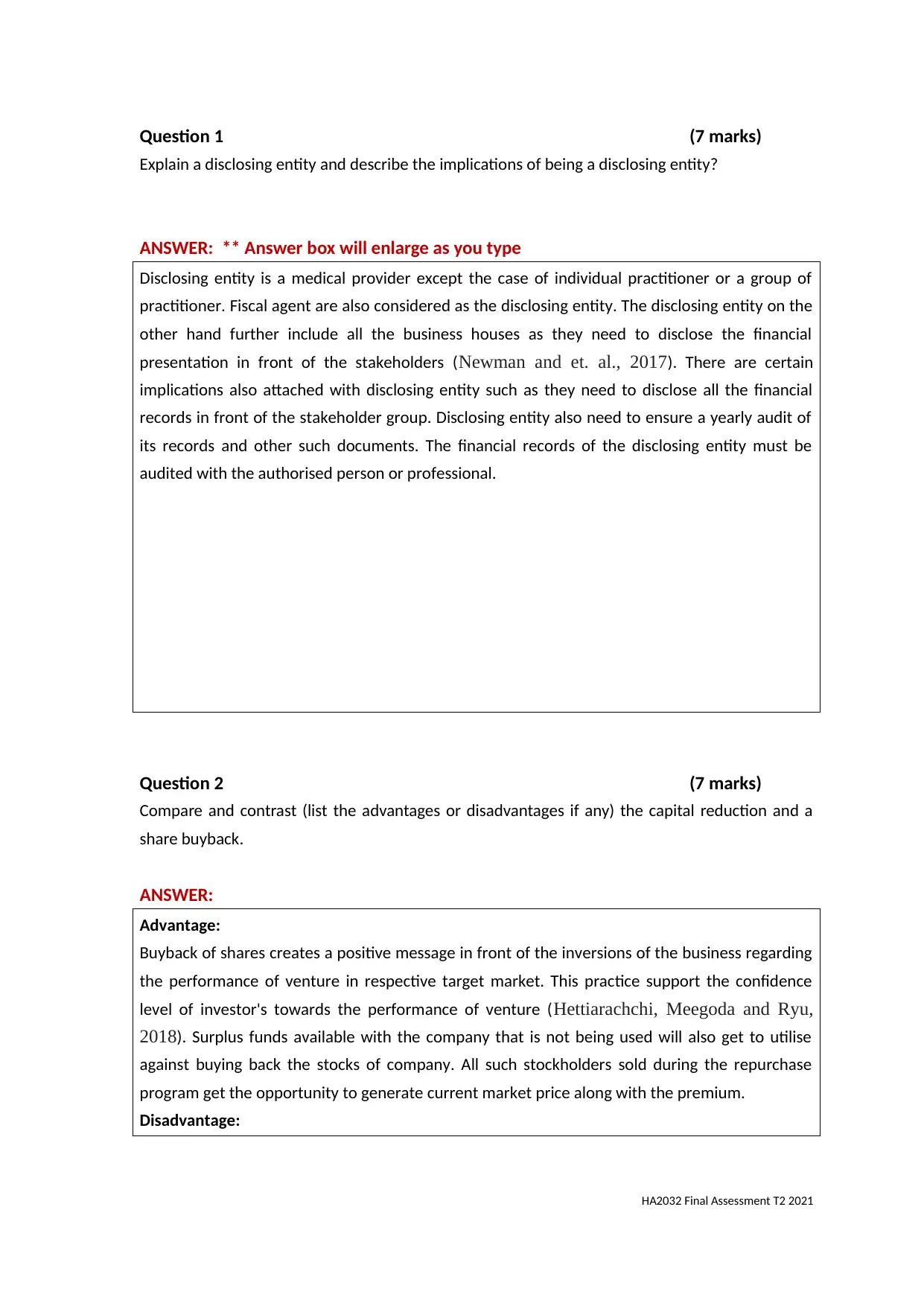
Question 1 (7 marks)
Explain a disclosing entity and describe the implications of being a disclosing entity?
ANSWER: ** Answer box will enlarge as you type
Disclosing entity is a medical provider except the case of individual practitioner or a group of
practitioner. Fiscal agent are also considered as the disclosing entity. The disclosing entity on the
other hand further include all the business houses as they need to disclose the financial
presentation in front of the stakeholders (Newman and et. al., 2017). There are certain
implications also attached with disclosing entity such as they need to disclose all the financial
records in front of the stakeholder group. Disclosing entity also need to ensure a yearly audit of
its records and other such documents. The financial records of the disclosing entity must be
audited with the authorised person or professional.
Question 2 (7 marks)
Compare and contrast (list the advantages or disadvantages if any) the capital reduction and a
share buyback.
ANSWER:
Advantage:
Buyback of shares creates a positive message in front of the inversions of the business regarding
the performance of venture in respective target market. This practice support the confidence
level of investor's towards the performance of venture (Hettiarachchi, Meegoda and Ryu,
2018). Surplus funds available with the company that is not being used will also get to utilise
against buying back the stocks of company. All such stockholders sold during the repurchase
program get the opportunity to generate current market price along with the premium.
Disadvantage:
HA2032 Final Assessment T2 2021
Explain a disclosing entity and describe the implications of being a disclosing entity?
ANSWER: ** Answer box will enlarge as you type
Disclosing entity is a medical provider except the case of individual practitioner or a group of
practitioner. Fiscal agent are also considered as the disclosing entity. The disclosing entity on the
other hand further include all the business houses as they need to disclose the financial
presentation in front of the stakeholders (Newman and et. al., 2017). There are certain
implications also attached with disclosing entity such as they need to disclose all the financial
records in front of the stakeholder group. Disclosing entity also need to ensure a yearly audit of
its records and other such documents. The financial records of the disclosing entity must be
audited with the authorised person or professional.
Question 2 (7 marks)
Compare and contrast (list the advantages or disadvantages if any) the capital reduction and a
share buyback.
ANSWER:
Advantage:
Buyback of shares creates a positive message in front of the inversions of the business regarding
the performance of venture in respective target market. This practice support the confidence
level of investor's towards the performance of venture (Hettiarachchi, Meegoda and Ryu,
2018). Surplus funds available with the company that is not being used will also get to utilise
against buying back the stocks of company. All such stockholders sold during the repurchase
program get the opportunity to generate current market price along with the premium.
Disadvantage:
HA2032 Final Assessment T2 2021
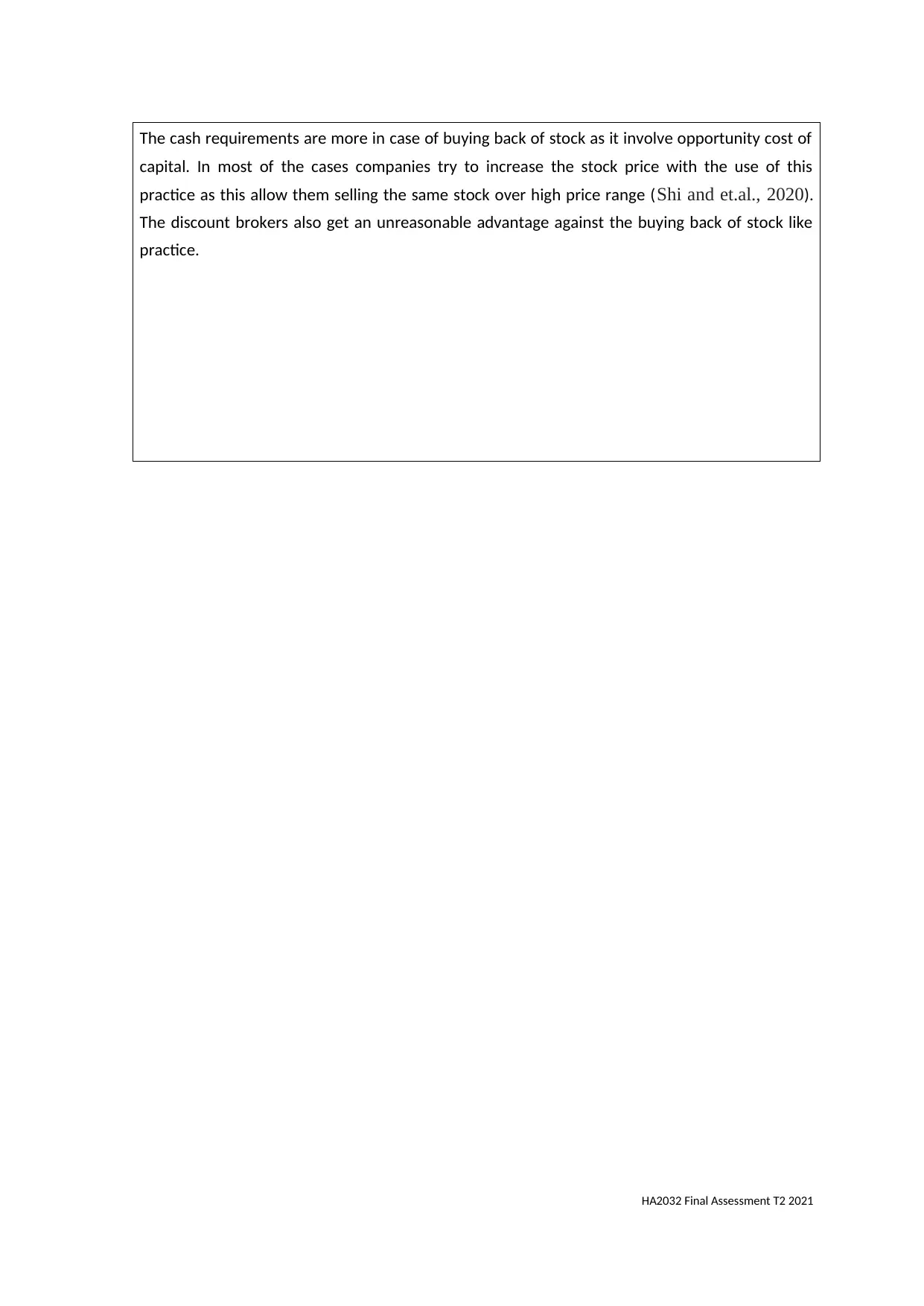
The cash requirements are more in case of buying back of stock as it involve opportunity cost of
capital. In most of the cases companies try to increase the stock price with the use of this
practice as this allow them selling the same stock over high price range (Shi and et.al., 2020).
The discount brokers also get an unreasonable advantage against the buying back of stock like
practice.
HA2032 Final Assessment T2 2021
capital. In most of the cases companies try to increase the stock price with the use of this
practice as this allow them selling the same stock over high price range (Shi and et.al., 2020).
The discount brokers also get an unreasonable advantage against the buying back of stock like
practice.
HA2032 Final Assessment T2 2021
⊘ This is a preview!⊘
Do you want full access?
Subscribe today to unlock all pages.

Trusted by 1+ million students worldwide
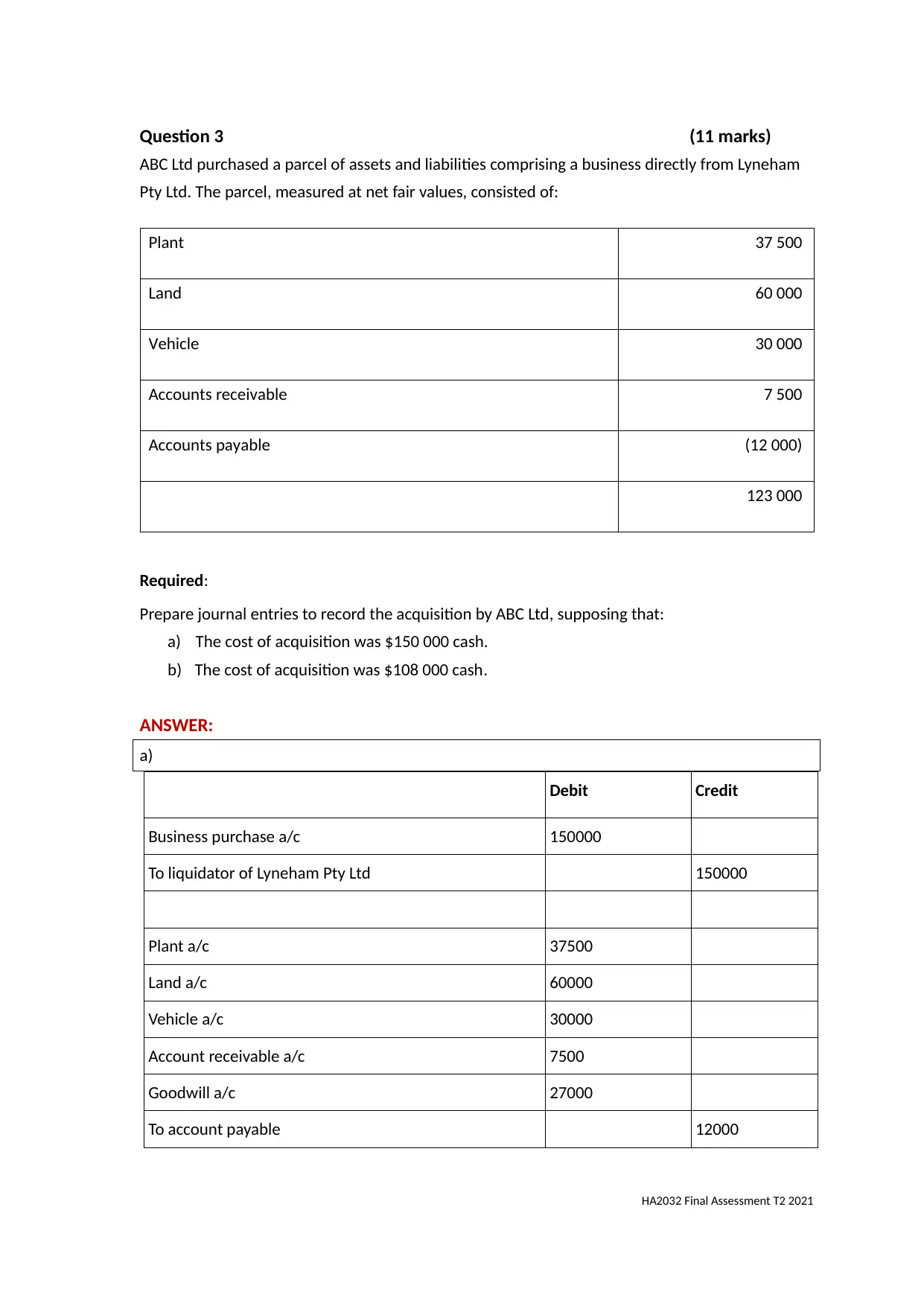
Question 3 (11 marks)
ABC Ltd purchased a parcel of assets and liabilities comprising a business directly from Lyneham
Pty Ltd. The parcel, measured at net fair values, consisted of:
Plant 37 500
Land 60 000
Vehicle 30 000
Accounts receivable 7 500
Accounts payable (12 000)
123 000
Required:
Prepare journal entries to record the acquisition by ABC Ltd, supposing that:
a) The cost of acquisition was $150 000 cash.
b) The cost of acquisition was $108 000 cash.
ANSWER:
a)
Debit Credit
Business purchase a/c 150000
To liquidator of Lyneham Pty Ltd 150000
Plant a/c 37500
Land a/c 60000
Vehicle a/c 30000
Account receivable a/c 7500
Goodwill a/c 27000
To account payable 12000
HA2032 Final Assessment T2 2021
ABC Ltd purchased a parcel of assets and liabilities comprising a business directly from Lyneham
Pty Ltd. The parcel, measured at net fair values, consisted of:
Plant 37 500
Land 60 000
Vehicle 30 000
Accounts receivable 7 500
Accounts payable (12 000)
123 000
Required:
Prepare journal entries to record the acquisition by ABC Ltd, supposing that:
a) The cost of acquisition was $150 000 cash.
b) The cost of acquisition was $108 000 cash.
ANSWER:
a)
Debit Credit
Business purchase a/c 150000
To liquidator of Lyneham Pty Ltd 150000
Plant a/c 37500
Land a/c 60000
Vehicle a/c 30000
Account receivable a/c 7500
Goodwill a/c 27000
To account payable 12000
HA2032 Final Assessment T2 2021
Paraphrase This Document
Need a fresh take? Get an instant paraphrase of this document with our AI Paraphraser
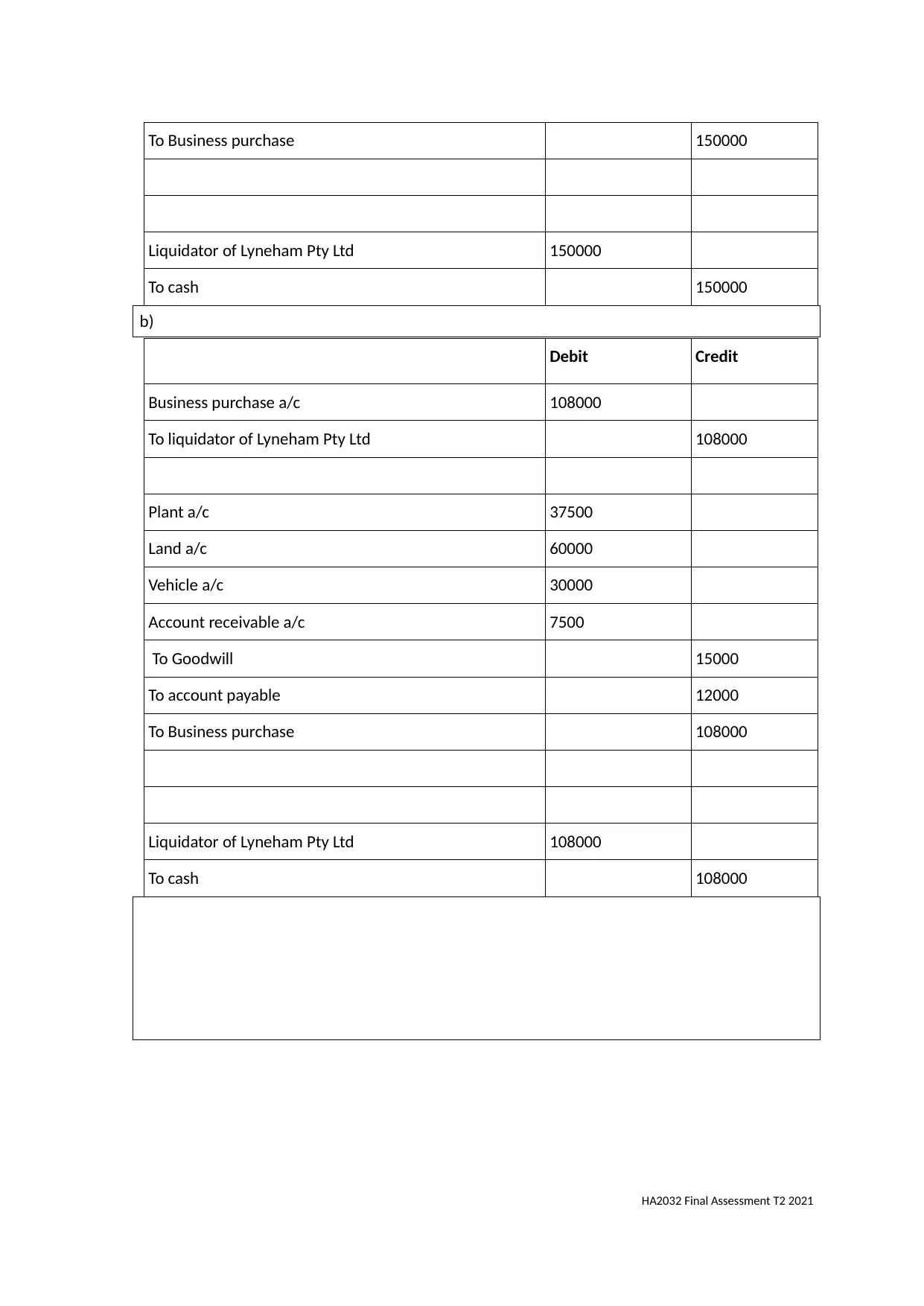
To Business purchase 150000
Liquidator of Lyneham Pty Ltd 150000
To cash 150000
b)
Debit Credit
Business purchase a/c 108000
To liquidator of Lyneham Pty Ltd 108000
Plant a/c 37500
Land a/c 60000
Vehicle a/c 30000
Account receivable a/c 7500
To Goodwill 15000
To account payable 12000
To Business purchase 108000
Liquidator of Lyneham Pty Ltd 108000
To cash 108000
HA2032 Final Assessment T2 2021
Liquidator of Lyneham Pty Ltd 150000
To cash 150000
b)
Debit Credit
Business purchase a/c 108000
To liquidator of Lyneham Pty Ltd 108000
Plant a/c 37500
Land a/c 60000
Vehicle a/c 30000
Account receivable a/c 7500
To Goodwill 15000
To account payable 12000
To Business purchase 108000
Liquidator of Lyneham Pty Ltd 108000
To cash 108000
HA2032 Final Assessment T2 2021
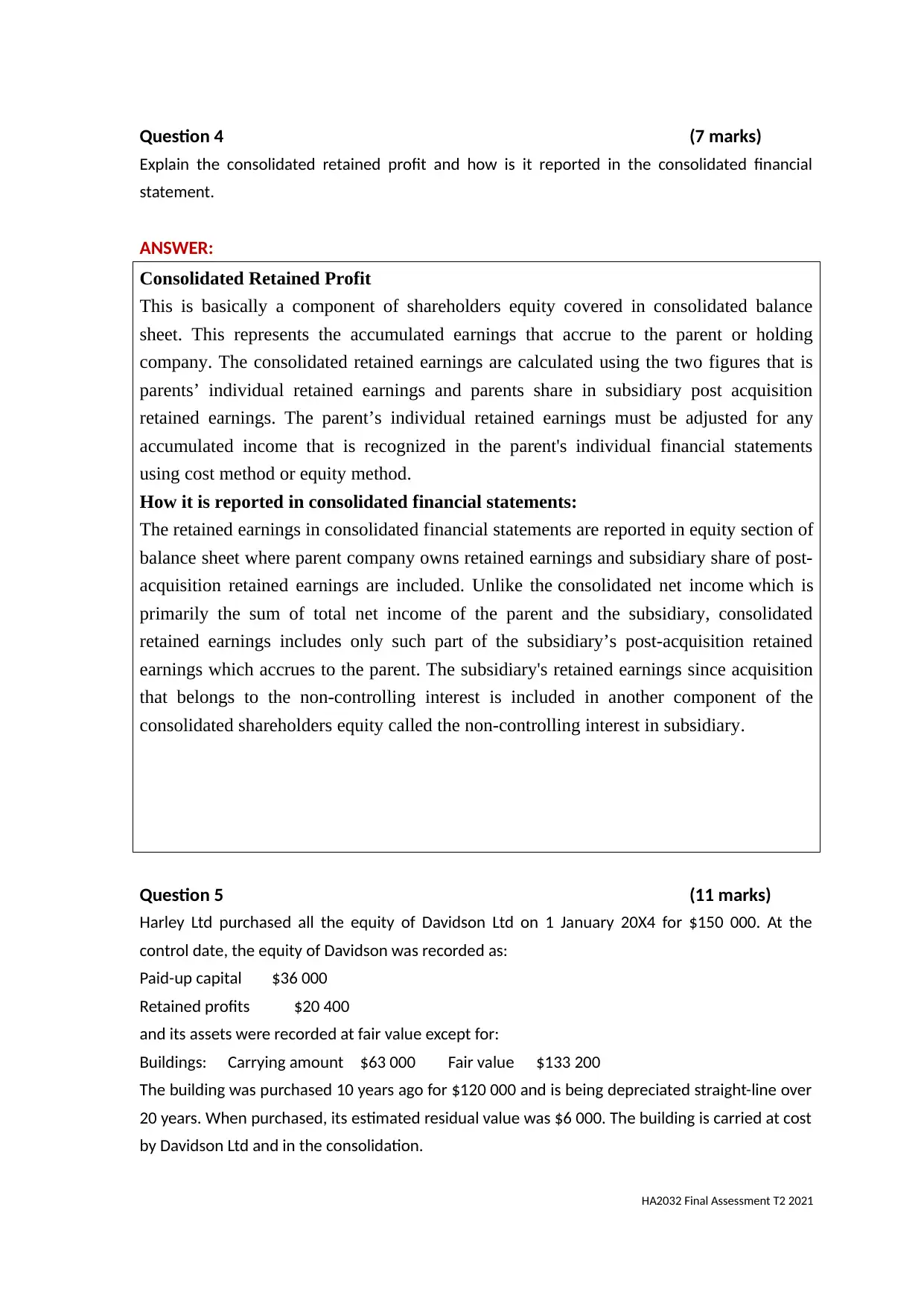
Question 4 (7 marks)
Explain the consolidated retained profit and how is it reported in the consolidated financial
statement.
ANSWER:
Consolidated Retained Profit
This is basically a component of shareholders equity covered in consolidated balance
sheet. This represents the accumulated earnings that accrue to the parent or holding
company. The consolidated retained earnings are calculated using the two figures that is
parents’ individual retained earnings and parents share in subsidiary post acquisition
retained earnings. The parent’s individual retained earnings must be adjusted for any
accumulated income that is recognized in the parent's individual financial statements
using cost method or equity method.
How it is reported in consolidated financial statements:
The retained earnings in consolidated financial statements are reported in equity section of
balance sheet where parent company owns retained earnings and subsidiary share of post-
acquisition retained earnings are included. Unlike the consolidated net income which is
primarily the sum of total net income of the parent and the subsidiary, consolidated
retained earnings includes only such part of the subsidiary’s post-acquisition retained
earnings which accrues to the parent. The subsidiary's retained earnings since acquisition
that belongs to the non-controlling interest is included in another component of the
consolidated shareholders equity called the non-controlling interest in subsidiary.
Question 5 (11 marks)
Harley Ltd purchased all the equity of Davidson Ltd on 1 January 20X4 for $150 000. At the
control date, the equity of Davidson was recorded as:
Paid-up capital $36 000
Retained profits $20 400
and its assets were recorded at fair value except for:
Buildings: Carrying amount $63 000 Fair value $133 200
The building was purchased 10 years ago for $120 000 and is being depreciated straight-line over
20 years. When purchased, its estimated residual value was $6 000. The building is carried at cost
by Davidson Ltd and in the consolidation.
HA2032 Final Assessment T2 2021
Explain the consolidated retained profit and how is it reported in the consolidated financial
statement.
ANSWER:
Consolidated Retained Profit
This is basically a component of shareholders equity covered in consolidated balance
sheet. This represents the accumulated earnings that accrue to the parent or holding
company. The consolidated retained earnings are calculated using the two figures that is
parents’ individual retained earnings and parents share in subsidiary post acquisition
retained earnings. The parent’s individual retained earnings must be adjusted for any
accumulated income that is recognized in the parent's individual financial statements
using cost method or equity method.
How it is reported in consolidated financial statements:
The retained earnings in consolidated financial statements are reported in equity section of
balance sheet where parent company owns retained earnings and subsidiary share of post-
acquisition retained earnings are included. Unlike the consolidated net income which is
primarily the sum of total net income of the parent and the subsidiary, consolidated
retained earnings includes only such part of the subsidiary’s post-acquisition retained
earnings which accrues to the parent. The subsidiary's retained earnings since acquisition
that belongs to the non-controlling interest is included in another component of the
consolidated shareholders equity called the non-controlling interest in subsidiary.
Question 5 (11 marks)
Harley Ltd purchased all the equity of Davidson Ltd on 1 January 20X4 for $150 000. At the
control date, the equity of Davidson was recorded as:
Paid-up capital $36 000
Retained profits $20 400
and its assets were recorded at fair value except for:
Buildings: Carrying amount $63 000 Fair value $133 200
The building was purchased 10 years ago for $120 000 and is being depreciated straight-line over
20 years. When purchased, its estimated residual value was $6 000. The building is carried at cost
by Davidson Ltd and in the consolidation.
HA2032 Final Assessment T2 2021
⊘ This is a preview!⊘
Do you want full access?
Subscribe today to unlock all pages.

Trusted by 1+ million students worldwide
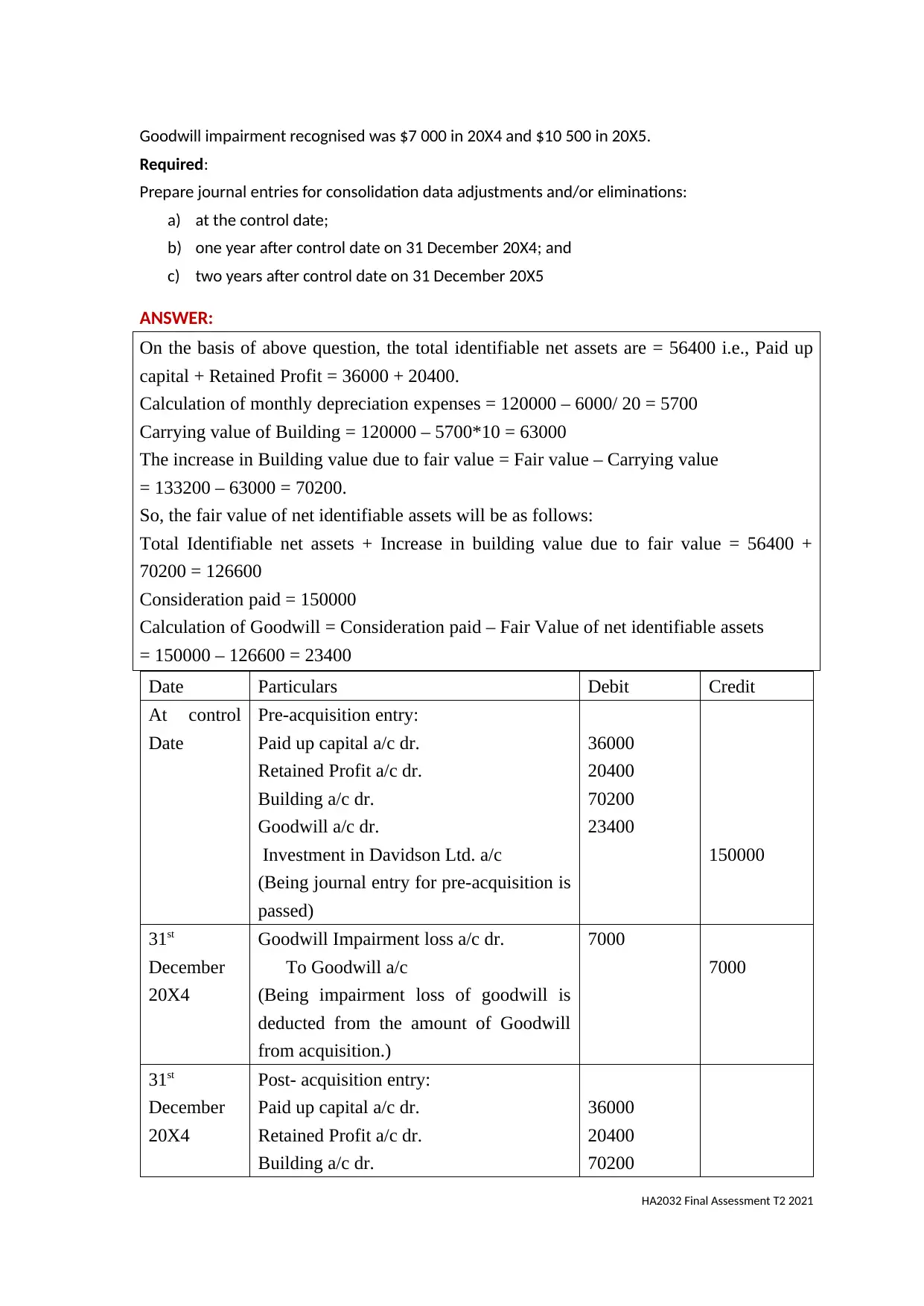
Goodwill impairment recognised was $7 000 in 20X4 and $10 500 in 20X5.
Required:
Prepare journal entries for consolidation data adjustments and/or eliminations:
a) at the control date;
b) one year after control date on 31 December 20X4; and
c) two years after control date on 31 December 20X5
ANSWER:
On the basis of above question, the total identifiable net assets are = 56400 i.e., Paid up
capital + Retained Profit = 36000 + 20400.
Calculation of monthly depreciation expenses = 120000 – 6000/ 20 = 5700
Carrying value of Building = 120000 – 5700*10 = 63000
The increase in Building value due to fair value = Fair value – Carrying value
= 133200 – 63000 = 70200.
So, the fair value of net identifiable assets will be as follows:
Total Identifiable net assets + Increase in building value due to fair value = 56400 +
70200 = 126600
Consideration paid = 150000
Calculation of Goodwill = Consideration paid – Fair Value of net identifiable assets
= 150000 – 126600 = 23400
Date Particulars Debit Credit
At control
Date
Pre-acquisition entry:
Paid up capital a/c dr.
Retained Profit a/c dr.
Building a/c dr.
Goodwill a/c dr.
Investment in Davidson Ltd. a/c
(Being journal entry for pre-acquisition is
passed)
36000
20400
70200
23400
150000
31st
December
20X4
Goodwill Impairment loss a/c dr.
To Goodwill a/c
(Being impairment loss of goodwill is
deducted from the amount of Goodwill
from acquisition.)
7000
7000
31st
December
20X4
Post- acquisition entry:
Paid up capital a/c dr.
Retained Profit a/c dr.
Building a/c dr.
36000
20400
70200
HA2032 Final Assessment T2 2021
Required:
Prepare journal entries for consolidation data adjustments and/or eliminations:
a) at the control date;
b) one year after control date on 31 December 20X4; and
c) two years after control date on 31 December 20X5
ANSWER:
On the basis of above question, the total identifiable net assets are = 56400 i.e., Paid up
capital + Retained Profit = 36000 + 20400.
Calculation of monthly depreciation expenses = 120000 – 6000/ 20 = 5700
Carrying value of Building = 120000 – 5700*10 = 63000
The increase in Building value due to fair value = Fair value – Carrying value
= 133200 – 63000 = 70200.
So, the fair value of net identifiable assets will be as follows:
Total Identifiable net assets + Increase in building value due to fair value = 56400 +
70200 = 126600
Consideration paid = 150000
Calculation of Goodwill = Consideration paid – Fair Value of net identifiable assets
= 150000 – 126600 = 23400
Date Particulars Debit Credit
At control
Date
Pre-acquisition entry:
Paid up capital a/c dr.
Retained Profit a/c dr.
Building a/c dr.
Goodwill a/c dr.
Investment in Davidson Ltd. a/c
(Being journal entry for pre-acquisition is
passed)
36000
20400
70200
23400
150000
31st
December
20X4
Goodwill Impairment loss a/c dr.
To Goodwill a/c
(Being impairment loss of goodwill is
deducted from the amount of Goodwill
from acquisition.)
7000
7000
31st
December
20X4
Post- acquisition entry:
Paid up capital a/c dr.
Retained Profit a/c dr.
Building a/c dr.
36000
20400
70200
HA2032 Final Assessment T2 2021
Paraphrase This Document
Need a fresh take? Get an instant paraphrase of this document with our AI Paraphraser
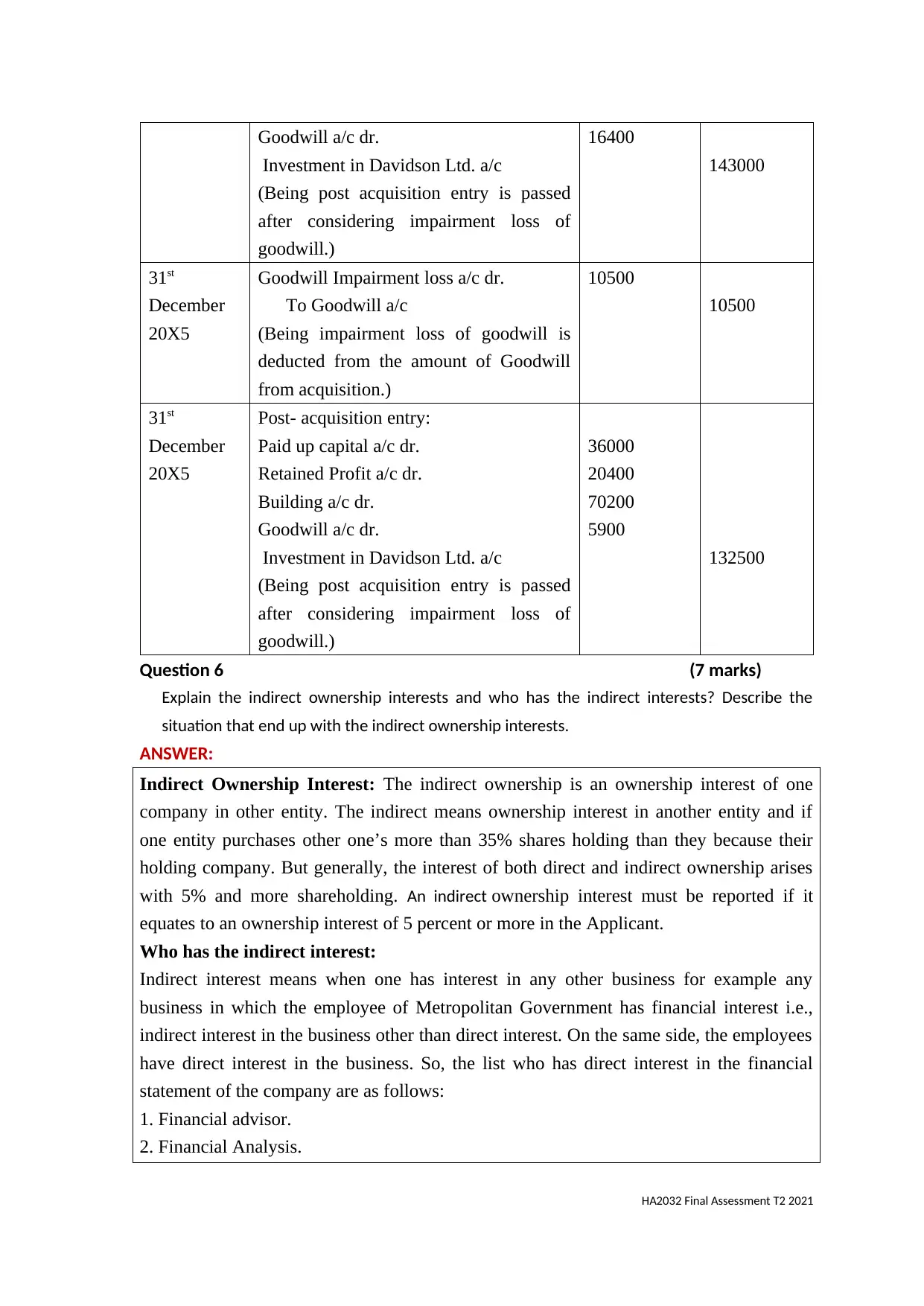
Goodwill a/c dr.
Investment in Davidson Ltd. a/c
(Being post acquisition entry is passed
after considering impairment loss of
goodwill.)
16400
143000
31st
December
20X5
Goodwill Impairment loss a/c dr.
To Goodwill a/c
(Being impairment loss of goodwill is
deducted from the amount of Goodwill
from acquisition.)
10500
10500
31st
December
20X5
Post- acquisition entry:
Paid up capital a/c dr.
Retained Profit a/c dr.
Building a/c dr.
Goodwill a/c dr.
Investment in Davidson Ltd. a/c
(Being post acquisition entry is passed
after considering impairment loss of
goodwill.)
36000
20400
70200
5900
132500
Question 6 (7 marks)
Explain the indirect ownership interests and who has the indirect interests? Describe the
situation that end up with the indirect ownership interests.
ANSWER:
Indirect Ownership Interest: The indirect ownership is an ownership interest of one
company in other entity. The indirect means ownership interest in another entity and if
one entity purchases other one’s more than 35% shares holding than they because their
holding company. But generally, the interest of both direct and indirect ownership arises
with 5% and more shareholding. An indirect ownership interest must be reported if it
equates to an ownership interest of 5 percent or more in the Applicant.
Who has the indirect interest:
Indirect interest means when one has interest in any other business for example any
business in which the employee of Metropolitan Government has financial interest i.e.,
indirect interest in the business other than direct interest. On the same side, the employees
have direct interest in the business. So, the list who has direct interest in the financial
statement of the company are as follows:
1. Financial advisor.
2. Financial Analysis.
HA2032 Final Assessment T2 2021
Investment in Davidson Ltd. a/c
(Being post acquisition entry is passed
after considering impairment loss of
goodwill.)
16400
143000
31st
December
20X5
Goodwill Impairment loss a/c dr.
To Goodwill a/c
(Being impairment loss of goodwill is
deducted from the amount of Goodwill
from acquisition.)
10500
10500
31st
December
20X5
Post- acquisition entry:
Paid up capital a/c dr.
Retained Profit a/c dr.
Building a/c dr.
Goodwill a/c dr.
Investment in Davidson Ltd. a/c
(Being post acquisition entry is passed
after considering impairment loss of
goodwill.)
36000
20400
70200
5900
132500
Question 6 (7 marks)
Explain the indirect ownership interests and who has the indirect interests? Describe the
situation that end up with the indirect ownership interests.
ANSWER:
Indirect Ownership Interest: The indirect ownership is an ownership interest of one
company in other entity. The indirect means ownership interest in another entity and if
one entity purchases other one’s more than 35% shares holding than they because their
holding company. But generally, the interest of both direct and indirect ownership arises
with 5% and more shareholding. An indirect ownership interest must be reported if it
equates to an ownership interest of 5 percent or more in the Applicant.
Who has the indirect interest:
Indirect interest means when one has interest in any other business for example any
business in which the employee of Metropolitan Government has financial interest i.e.,
indirect interest in the business other than direct interest. On the same side, the employees
have direct interest in the business. So, the list who has direct interest in the financial
statement of the company are as follows:
1. Financial advisor.
2. Financial Analysis.
HA2032 Final Assessment T2 2021
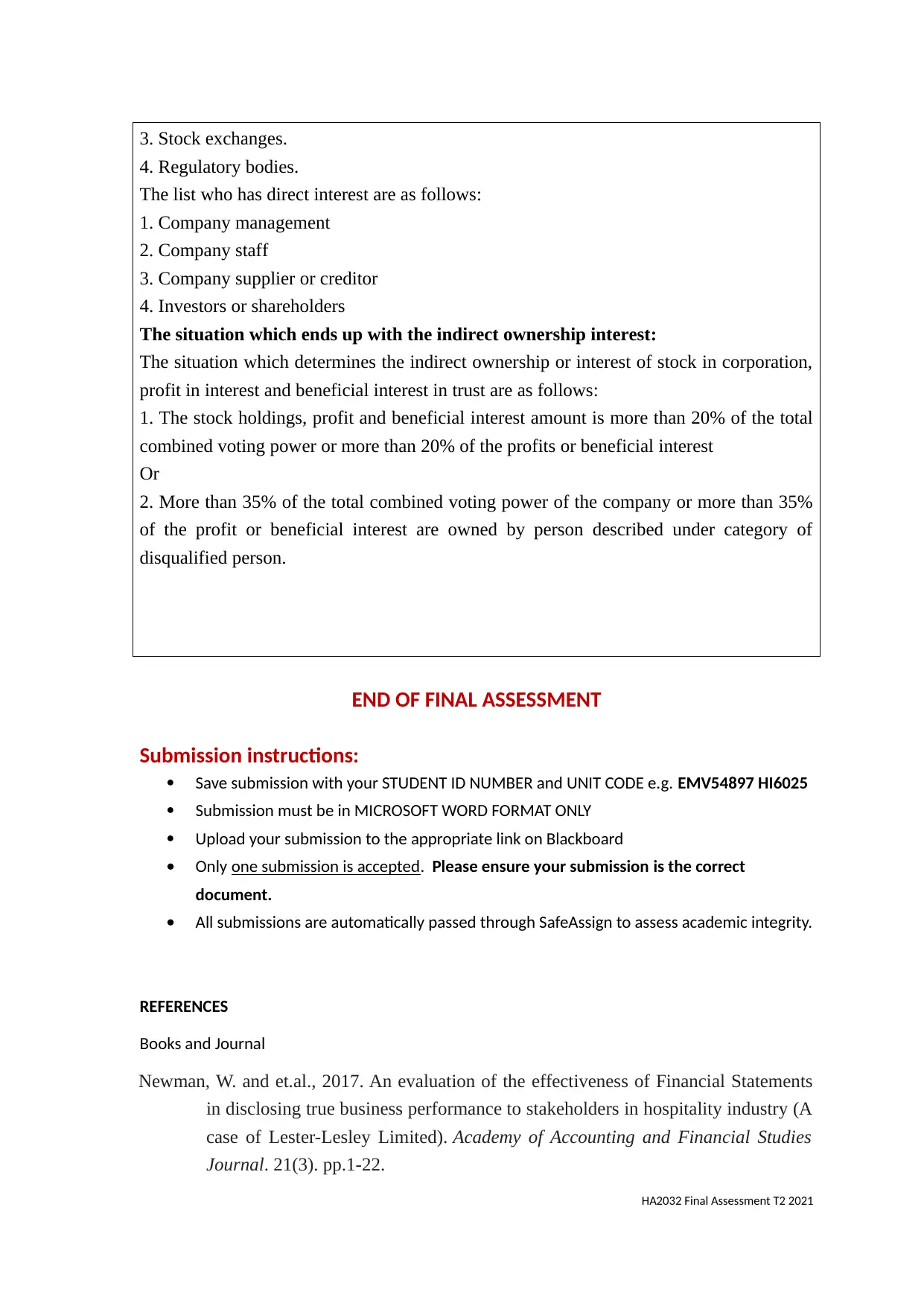
3. Stock exchanges.
4. Regulatory bodies.
The list who has direct interest are as follows:
1. Company management
2. Company staff
3. Company supplier or creditor
4. Investors or shareholders
The situation which ends up with the indirect ownership interest:
The situation which determines the indirect ownership or interest of stock in corporation,
profit in interest and beneficial interest in trust are as follows:
1. The stock holdings, profit and beneficial interest amount is more than 20% of the total
combined voting power or more than 20% of the profits or beneficial interest
Or
2. More than 35% of the total combined voting power of the company or more than 35%
of the profit or beneficial interest are owned by person described under category of
disqualified person.
END OF FINAL ASSESSMENT
Submission instructions:
Save submission with your STUDENT ID NUMBER and UNIT CODE e.g. EMV54897 HI6025
Submission must be in MICROSOFT WORD FORMAT ONLY
Upload your submission to the appropriate link on Blackboard
Only one submission is accepted. Please ensure your submission is the correct
document.
All submissions are automatically passed through SafeAssign to assess academic integrity.
REFERENCES
Books and Journal
Newman, W. and et.al., 2017. An evaluation of the effectiveness of Financial Statements
in disclosing true business performance to stakeholders in hospitality industry (A
case of Lester-Lesley Limited). Academy of Accounting and Financial Studies
Journal. 21(3). pp.1-22.
HA2032 Final Assessment T2 2021
4. Regulatory bodies.
The list who has direct interest are as follows:
1. Company management
2. Company staff
3. Company supplier or creditor
4. Investors or shareholders
The situation which ends up with the indirect ownership interest:
The situation which determines the indirect ownership or interest of stock in corporation,
profit in interest and beneficial interest in trust are as follows:
1. The stock holdings, profit and beneficial interest amount is more than 20% of the total
combined voting power or more than 20% of the profits or beneficial interest
Or
2. More than 35% of the total combined voting power of the company or more than 35%
of the profit or beneficial interest are owned by person described under category of
disqualified person.
END OF FINAL ASSESSMENT
Submission instructions:
Save submission with your STUDENT ID NUMBER and UNIT CODE e.g. EMV54897 HI6025
Submission must be in MICROSOFT WORD FORMAT ONLY
Upload your submission to the appropriate link on Blackboard
Only one submission is accepted. Please ensure your submission is the correct
document.
All submissions are automatically passed through SafeAssign to assess academic integrity.
REFERENCES
Books and Journal
Newman, W. and et.al., 2017. An evaluation of the effectiveness of Financial Statements
in disclosing true business performance to stakeholders in hospitality industry (A
case of Lester-Lesley Limited). Academy of Accounting and Financial Studies
Journal. 21(3). pp.1-22.
HA2032 Final Assessment T2 2021
⊘ This is a preview!⊘
Do you want full access?
Subscribe today to unlock all pages.

Trusted by 1+ million students worldwide
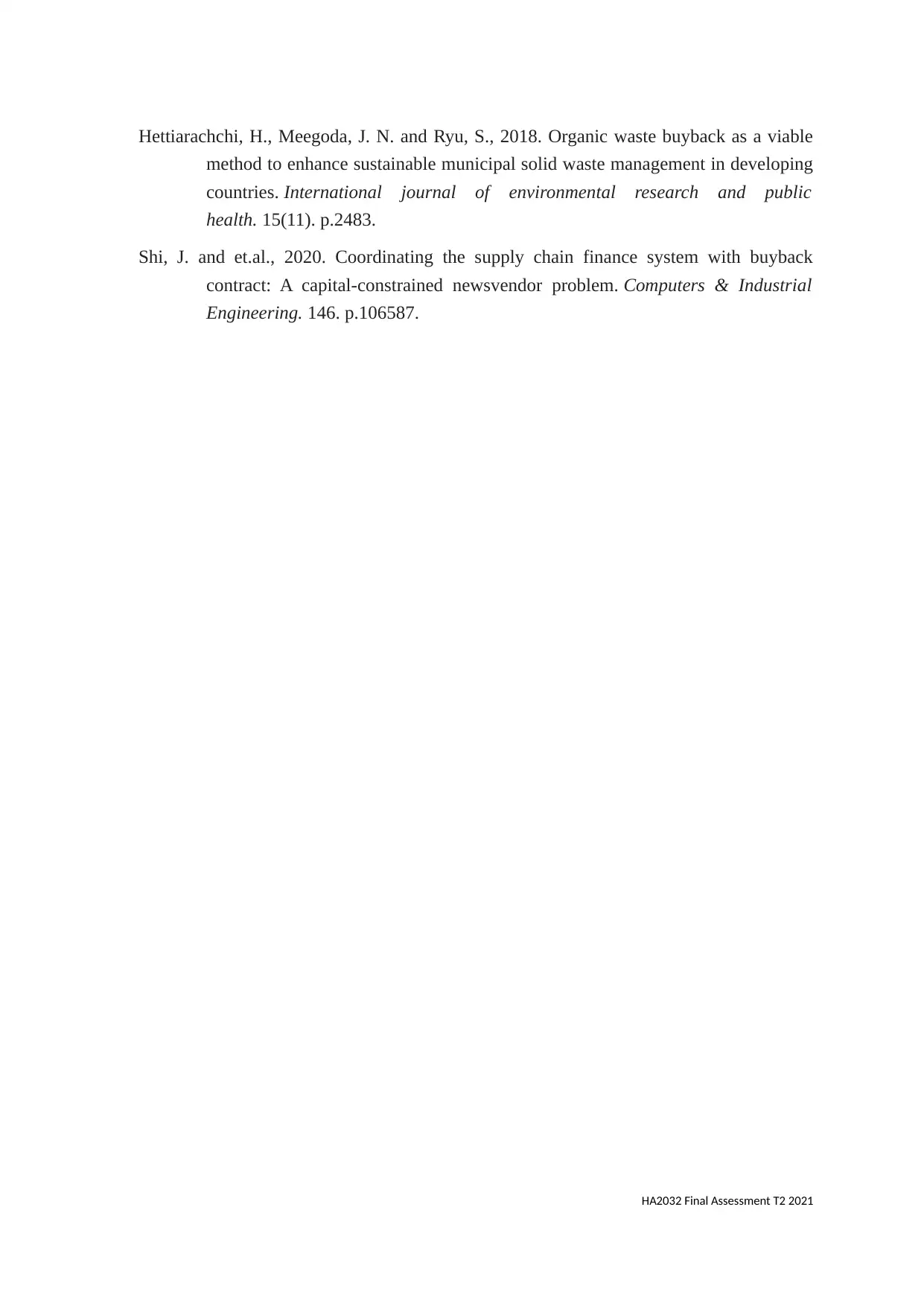
Hettiarachchi, H., Meegoda, J. N. and Ryu, S., 2018. Organic waste buyback as a viable
method to enhance sustainable municipal solid waste management in developing
countries. International journal of environmental research and public
health. 15(11). p.2483.
Shi, J. and et.al., 2020. Coordinating the supply chain finance system with buyback
contract: A capital-constrained newsvendor problem. Computers & Industrial
Engineering. 146. p.106587.
HA2032 Final Assessment T2 2021
method to enhance sustainable municipal solid waste management in developing
countries. International journal of environmental research and public
health. 15(11). p.2483.
Shi, J. and et.al., 2020. Coordinating the supply chain finance system with buyback
contract: A capital-constrained newsvendor problem. Computers & Industrial
Engineering. 146. p.106587.
HA2032 Final Assessment T2 2021
1 out of 10
Related Documents
Your All-in-One AI-Powered Toolkit for Academic Success.
+13062052269
info@desklib.com
Available 24*7 on WhatsApp / Email
![[object Object]](/_next/static/media/star-bottom.7253800d.svg)
Unlock your academic potential
Copyright © 2020–2025 A2Z Services. All Rights Reserved. Developed and managed by ZUCOL.


